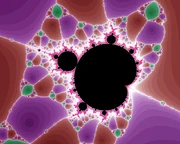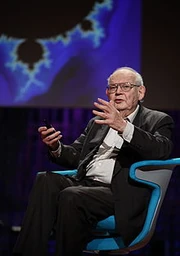
a Mandelbrodt set

Mandelbrodt in 2010 at TED
1924-2010
Discovered "fractals", i.e. figures which repeat themselves on different scales. See Arthur Clarke's video "The Colors of Infinity"
Read:Mandelbrodt in his own words, "Web of stories"
Notes:
1. Key to his success as a student: replacing algebra with pictures, geometry.
2. Saw authority crumble during the war, and so is not easy in conforming to authority.
3. Wants to combine pure math with a practical field.
4. People he admires most: Norbert Weiner and John von Newmann
5. Frontiers for von Neumann: space and economics. He did things by himself, e.g. put together the computer.
6. Right after “sputnik” (1950’s) people with advanced degrees in hard-sciences are wanted all over.
7. Looks for a place where he can “function outside the system”, sees himself as a misfit.
8. Theory of revolution is something that must be created more or less from scratch. Essentially, it is dialectics, i.e. theory of knowledge, in a materialist, social-revolutionary sense.
9. Strategy of research and tactics of research
10. “Self-similar shapes” – that is the key to the structure of reality. It is self-similar at different levels. The Universe is a fractal. This means that in every part of it there is a replica of the whole. See site of Robert Oldershow "Fractal Cosmology".
11. Fractal geometry is a unifying theory. For objects as different as prices and physics become part of its domain. Very different objects have a “commonality of structure”, e.g. revolution in science and revolution in society. (Hence, need to re-read “Structure of Scientific Revolutions” and criticize, work notes for developing it further.)
12. Fractal – each part is similar to the whole, except on a different scale (smaller).
13. The goal of science is to reduce all the complex phenomena to some basic concepts, from development of which everything else follows. Such basic concept may be “knowledge”. One tool in developing it may be “map of knowledge”. Its importance lies in ability to sketch the areas we know, and hence in fixing the things we don’t know. Thus, it creates a program, or a plan, of research.
14. What was in 1982 the task for adults has become, with the help of development of computers, a task for children 15 years later. It is the same in all fields of knowledge.
15. Galaxies are fractaly distributed
16. "scientists look for invariances"
17. When one gives a talk, one should talk as though to one's children, e.g. Darwin's autobiography for his children. Otherwise, one is not understood.
18. Theory of M. comes from observing very different, seemingly non-related processes, such as Dali picture, behavior of stock markets, roughness of metals, Brownian motion, and observing similarity, “symmetry” between them. This proves that there is a future for a unified theory of knowledge.
19. Theory of fractals is a part of the theory of chaos. Fractals also a part of cosmology, as the Universe has a fractal nature, i.e. the same patters repeating themselves on different scales.
20. Fractals are “a frontier of science”.
21. Fractal geometry approximates reality, while the older math is becoming more removed from it.
22. Beauty is an essential part of this new math. Theory of Aesthetics.
23. The last artist he mentions is Kandisky, http://en.wikipedia.org/wiki/Kandinsky His art is very fractal in nature.
24. Scientific theory consists of a number of invariants, generalizations, which are developed, and then compared with known facts. Then, use the facts to fine-tune the theory.
25. M. speaks only of “intellectual challenges” in many fields. But revolution is not solely an intellectual challenge, although theory of revolution is of #1 importance. One attempts to combine intellectual and physical. That’s the frontier.
- 26. Music in every culture and every time period is fractal. In other words, a structure in one part (scale) is repeated in a different scale (e.g. Bach pieces). Fractals are beautiful in the sense that beauty is a harmony of parts. I.e. small parts are replicas of the large. Hence, theory of fractals merges upon the theory of beauty. Fractal nature of the Universe makes harmony possible. Beauty consists in this harmony, this “accord” between different spheres of existence, as it makes knowledge possible, understanding “B” from understanding “A”.
Mandelbrodt, "Fractal Geometry of Nature", 1982
1. (Rus.) «подходящий неологизм (новый термин) удобнее, чем новое значение и без того затертого до дыр термина»
2. The concept of “length of a coastline” is not objective, but depends upon the person who does the measurement. The smaller is his yardstick, the greater is the result obtained.
3. Self-similarity is also interesting because of "self-reproducing systems" of J. von Neumann. The two developments must converge in nanotechnology
4. To describe vs. to explain - first is boring, second can be tested as it necessarily makes predictions, and hence involves dialectic logic
Benoit Mandelbrot: Fractals and the art of roughness
http://www.ted.com/talks/benoit_mandelbrot_fractals_the_art_of_roughness.html
Finding order in a mess.
Each part is like the whole, but smaller.
“The closer you measure, the longer it is”. For example, the closer one attempts to study a history of X, the more is the story. This implies that all knowledge is fractal, just like the shapes of a coastline. Knowledge itself is a fractal. What does one do about this?
“bottomless wonders spring out from simple rules which are repeated without end” one example: z-> z^2 + c (a Mandelbrot set)
Fractals show that one set of rules is at the bottom of such diverse shapes as “a tree” and a “river delta”. More interesting are the fractals which display a vortex shape, as a universal form of development. This has implications for "systems theory ".